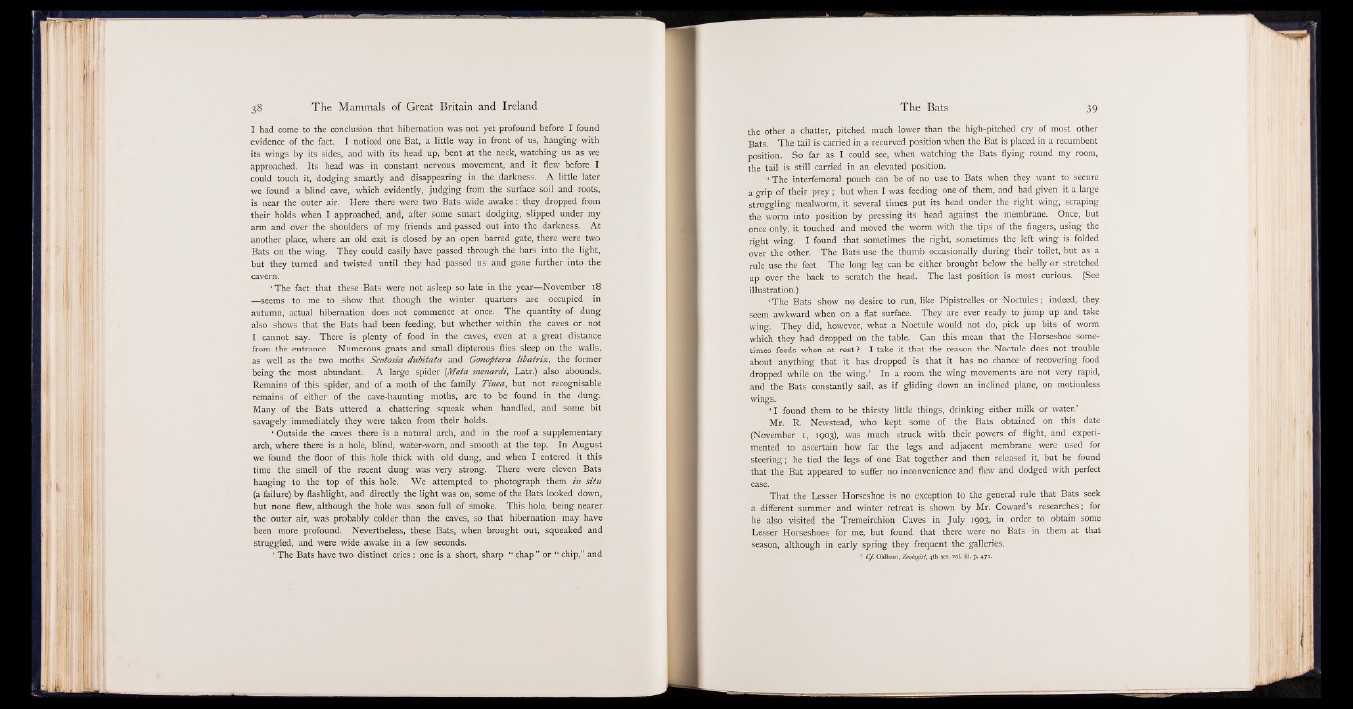
I had come to the conclusion that hibernation was not yet profound before I found
evidence of the fact. I noticed one Bat, a little way in front of us, hanging with
its wings by its sides, and with its head up, bent at the neck, watching us as we
approached. Its head was in constant nervous movement, and it flew before I
could touch it, dodging smartly and disappearing in the. darkness. A little later
we found a blind cave, which evidently, judging from the surface soil and roots,
is near the outer air. Here there were two Bats wide awake: they dropped from
their holds when I approached, and, after some smart dodging, slipped under my
arm and over the shoulders of my friends and passed out into the darkness. At
another place, where an old exit is closed by an open barred gate, there were two
Bats on the wing. They could easily have passed through the bars into the light,
but they turned and twisted until they had passed us and gone further into the
cavern.
‘ The fact that these Bats were not asleep so late in the year— November 18
— seems to me to show that though the winter quarters are occupied in
autumn, actual hibernation does not commence at once. The quantity of dung
also shows that the Bats had been feeding, but whether within the caves or not
I cannot say. There is plenty of food in the caves, even at a great distance
from the entrance. Numerous gnats and small dipterous flies sleep on the walls,
as well as the two moths Scotosia dubitata and Gonoptera libatrix, the former
being the most abundant. A large spider (Meta menardi, Latr.) also abounds.
Remains of this spider, and of a moth of the family Tinea, but not recognisable
remains of either of the cave-haunting moths, are to be found in the dung.
Many of the Bats uttered a chattering squeak when handled, and some bit
savagely immediately they were taken from their holds,
‘ Outside the caves there is a natural arch, and in the roof a supplementary
arch, where there is a hole, blind, water-worn, and smooth at the top. In August
we found the floor of this hole thick with old dung, and when I entered it this
time the smell of the recent dung was very strong. There were eleven Bats
hanging to the top of this hole. We attempted to photograph them in situ
(a failure) by flashlight, and directly the light was on, some of the Bats looked down,
but none flew, although the hole was soon full of smoke. This hole, being nearer
the outer air, was probably colder than the caves, so that hibernation may have
been more profound. Nevertheless, these Bats, when brought out, squeaked and
struggled, and were wide awake in a few seconds.
‘ The Bats have two distinct cries: one is a short, sharp “ chap ” or “ chip,” and
the other a chatter, pitched much lower than the high-pitched cry of most other
Bats. The tail is carried in a recurved position when the Bat is placed in a recumbent
position. So far as I could see, when watching the Bats flying round my room,
the tail is still carried in an elevated position.
‘ The interfemoral pouch can be of no use to Bats when they want to secure
a grip of their prey ; but when I was feeding one of them, and had given it a large
struggling mealworm, it several times put its head under the right wing, scraping
the worm into position by pressing its head against the membrane. Once, but
once only, it touched and moved the worm with the tips of the fingers, using the
right wing. I found that sometimes the right, sometimes the left wing is folded
over the other. The Bats use the thumb occasionally during their toilet, but as a
rule use the feet. The long leg can be either brought below the belly or stretched
up over the back to scratch the head. The last position is most curious/ (See
illustration.)
‘ The Bats show no desire to run, like Pipistrelles or Noctules; indeed, they
seem awkward when on a flat surface. They are ever ready to jump up and take
wing. They did, however, what a Noctule would not do, pick up bits of worm
which they had dropped on the table. Can this mean that the Horseshoe sometimes
feeds when at rest? I take it that the reason the Noctule does not trouble
about anything that it has dropped is that it has no chance of recovering food
dropped while on the wing.1 In a room the wing movements are not very rapid,
and the Bats constantly sail, as if gliding down an inclined plane, on motionless
wings.
‘ I found them to be thirsty little things, drinking either milk or water.’
Mr. R. Newstead, who kept some of the Bats obtained on this date
(November i, 1903), was much struck with their powers of flight, and experimented
to ascertain how far the legs and adjacent membrane were used for
steering; he tied the legs of one Bat together and then released it, but he found
that the Bat appeared to suffer no inconvenience and flew and dodged with perfect
ease.
That the Lesser Horseshoe is no exception to the general rule that Bats seek
a different summer and winter retreat is shown by Mr. Coward’s researches; for
he also visited the Tremeirchion Caves in July 1903» in order to obtain some
Lesser Horseshoes for me, but found that there were no Bats in them at that
season, although in early spring they frequent the galleries.
1 Cf. Oldham, Zoologist; 4th ser. vol. iii. p. 471.